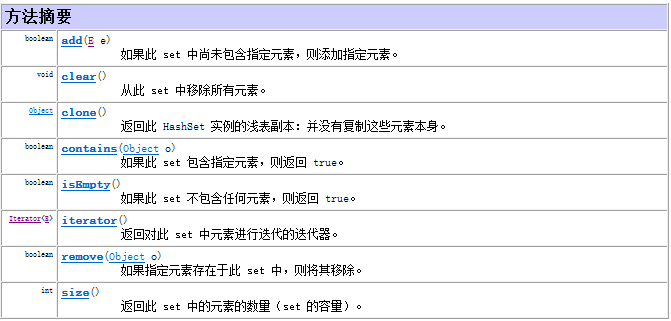Java 集合-Set接口及其子類
阿新 • • 發佈:2017-10-31
允許 ret ins ict amp println out ++ ||
2017-10-31 19:20:45
Set:無序且唯一
實現子類:HashSet,
- HashSet
此類實現 Set 接口,由哈希表(實際上是一個 HashMap 實例)支持。它不保證 set 的叠代順序;特別是它不保證該順序恒久不變。此類允許使用 null 元素。
註意,此實現不是同步的。如果多個線程同時訪問一個哈希 set,而其中至少一個線程修改了該 set,那麽它必須 保持外部同步。
HashSet底層數據結構是哈希表(HashMap),哈希表依賴於哈希值存儲,添加功能底層依賴兩個方法:int hashCode(),boolean equals(Object obj)。
*構造方法

*常用方法

HashSet唯一性的解釋:
源碼剖析:添加功能底層依賴兩個方法:int hashCode(),boolean equals(Object obj)
//HashSet類
class HashSet implements Set{
private static final Object PRESENT = new Object();
private transient HashMap<E,Object> map;
// 構造方法,返回了一個HashMap
public HashSet() {
map = new HashMap<>();
}
//add方法
public boolean add(E e) {
return map.put(e, PRESENT)==null;
}
}
//HashMap類
class HashMap implements Map{
public V put(K key, V value) {
return putVal(hash(key), key, value, false, true);
}
final V putVal(int hash, K key, V value, boolean onlyIfAbsent,
boolean evict) {
Node<K,V>[] tab; Node<K,V> p; int n, i;
if ((tab = table) == null || (n = tab.length) == 0)
n = (tab = resize()).length;
if ((p = tab[i = (n - 1) & hash]) == null)
tab[i] = newNode(hash, key, value, null);
else {
Node<K,V> e; K k;
if (p.hash == hash &&
((k = p.key) == key || (key != null && key.equals(k))))
e = p;
else if (p instanceof TreeNode)
e = ((TreeNode<K,V>)p).putTreeVal(this, tab, hash, key, value);
else {
for (int binCount = 0; ; ++binCount) {
if ((e = p.next) == null) {
p.next = newNode(hash, key, value, null);
if (binCount >= TREEIFY_THRESHOLD - 1) // -1 for 1st
treeifyBin(tab, hash);
break;
}
if (e.hash == hash &&
((k = e.key) == key || (key != null && key.equals(k))))
break;
p = e;
}
}
if (e != null) { // existing mapping for key
V oldValue = e.value;
if (!onlyIfAbsent || oldValue == null)
e.value = value;
afterNodeAccess(e);
return oldValue;
}
}
++modCount;
if (++size > threshold)
resize();
afterNodeInsertion(evict);
return null;
}
}
一個實例問題,在這種添加自定義對象的時候,兩個類的屬性值相等,但是依然會被判定為不同的元素,因為沒有重寫hashCode(),所以默認調用的是Object類的hashCode(),而不同類的hashCode一般是不同的。
HashSet<Student> hashSet = new HashSet<>();
Student s1 = new Student("劉亦菲", 22);
Student s2 = new Student("章子怡", 25);
Student s3 = new Student("劉亦菲", 22);
hashSet.add(s1);
hashSet.add(s2);
hashSet.add(s3);
System.out.println(hashSet);
解決方法就是自己重寫hashCode() 和 equals()方法:
public class Student {
private String name;
private Integer age;
Student(String name,int age)
{
this.name=name;
this.age=age;
}
@Override
public int hashCode() {
// return 0;
return this.name.hashCode()+this.age*11;
}
@Override
public boolean equals(Object obj) {
if(this == obj)
return true;
if(!(obj instanceof Student))
return false;
Student s = (Student) obj;
return this.name.equals(s.name) && this.age.equals(s.age);
}
}
這裏用到了instanceof操作符,這個操作符和== ,>=是同種性質的,只是是用英文描述的,是二元操作符,用來判斷左邊的是否為這個特定類或者是它的子類的一個實例。
Java 集合-Set接口及其子類
